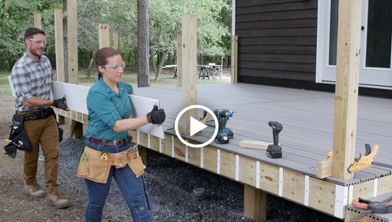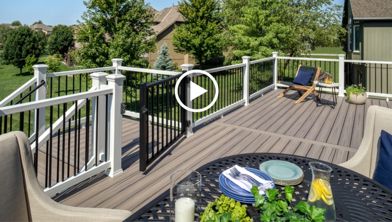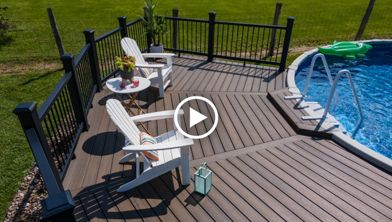For any home project, be certain to follow local code and permitting requirements.
Whether you’re looking to add ambiance or functionality to your outdoor space, the right deck lighting is one of the most impactful enhancements you can make to your deck. Learning how to install low-voltage deck lighting is fairly simple, provided only that you use a low-voltage lighting system and carefully read all manufacturer instructions.
Installing low-voltage deck lighting is inherently safer than installing household line voltage fixtures inside your home. And unless you need to run additional line-voltage circuits to feed a transformer, you probably won’t need an electrician or contractor for even a fairly elaborate deck lighting installation.
Develop a Lighting Plan
First, you’ll want to position your lights so that they’ll illuminate the appropriate areas. Each light will need to connect with a 12V transformer. Planning your deck lighting installation prior to installing any low-voltage deck lighting is essential to making sure you achieve both of those goals.
Start by identifying the locations of AC power sockets for plugging in the transformer. Once you’ve done that, you’re ready to start making approximate measurements for the length of wiring necessary to run your lights, and how many transformers you might need for your project.
Installing Trex deck lighting can make this easy because the LightHub connection system allows for the addition of a variety of accessories, including splitters, adapters, and customizable lengths of extension cabling. Trex also has an interactive online Lighting Transformer Calculator to help make sure you don’t overload the transformer. Overloaded transformers can fail prematurely and potentially cause fixture performance problems.
Connect Your Transformer
Low voltage deck lighting systems will require a deck lighting transformer, which is used to convert the ordinary household “line voltage” (120V) produced by an electrical socket. Most installations call for 12V transformers, so you only have to concern yourself with ensuring the transformer you choose can withstand the total wattage of all connected lights (most manufacturers have more than one sized transformer).
One important note: Not all 12V transformers are created equal. Some, often less expensive transformers, are simple “step-down” units that simply take 120VAC and step it down to 12VAC. The other option is to use transformers that change the voltage type from AC (Alternating Current, like your home uses) to DC (Direct Current, like your cell phone charger) while reducing the voltage from 120V to 12V. It’s important to know which type of voltage (i.e. AC vs DC) your lighting fixtures take, as the wrong voltage type can cause major component failure and other performance problems (and may even void your warranty). Also, it’s absolutely critical that you never mix AC and DC fixtures on the same circuit. For this reason, it’s highly recommended to use the same brand transformer as the light fixtures and to stick to one brand of fixtures.
One last power supply consideration: if you have an excessively long wire run (for example, over 300 feet) you might consider sourcing your own wire and stepping up to 16GA UL-listed outdoor rated 2 conductor wire. The issue this potentially solves is a problem called voltage drop. In basic terms, the longer the electricity has to run the more energy it loses at the end of the run. If you use a thicker (or lower gauge) wire you will minimize the chances that this can happen. If the system you’re installing uses a proprietary plug and play installation system, it’s normally appropriate to cut and hardwire the connections (but always check with your manufacturer for more information).
Install Wire Splitters
Some systems, such as the Trex Lighthub® system, use wire splitters to eliminate the need for cutting and splicing. Wire splitters transform one female connection into several, which makes adding them necessary along every post base where you want lighting. You’ll get a 5’ wire with each light fixture from Trex, so all you need to plan to buy are the splitters and the wires that connect each splitter together. Also, don’t fully attach the splitters to the joist. Leave them loose so you can maneuver them as you insert the Lighthub plugs.
More importantly, do not use an extension cord between the electrical outlet and the transformer, rather, connect the transformer directly into the power outlet. If the transformer cable does not reach the splitter, then you may need a wire extension cable, one which is designed to connect after the splitter.
Lastly, you’ll need to ensure the circuit the lighting is installed on has active and functional GFCI protection. This helps ensure spikes and other electrical anomalies won’t fry your lighting system (although massive spikes like lightning strikes are impossible to fully protect against).
Staple Wiring to Deck Frame
Hiding away wiring is critical for both safety and aesthetics. In most circumstances, your best option is attaching the wiring directly to your deck’s frame – almost any place that’s out of sight. Always use cable-safe staples or fasteners. Typical metal staples (for example, T50 type) have a high likelihood of penetrating the insulation of the wire and causing shorts.
Installing Your Deck Lighting
Depending on the type of deck lighting options you choose, there are some best practices to keep in mind when installing each one. The #1 tip for Trex® DeckLighting™, whether using plug and play or splicing wires, is to install with the power on. It’s essentially troubleshooting while installing. Always check with the manufacturer if you plan to use a different brand - just to double check that this method is safe with their system.
Post Cap Lights
The wiring that powers post caps comes up from below your deck. To install it, it’s best if the post sleeve isn’t on the 4X4 post. If your post is there, the process is much more difficult as the passage you have to run the wire is very small. Cable staple (or simply use painter’s tape) to hold the included 5’ wire in place and slide the post sleeve over the post. Connect the wire under the deck to the splitter, then plug in the cap light, making sure it works before moving on.
Remember to leave slack at the wiring towards the top of the post cap, ensuring you have room for installing post cap light without a struggle. Start with the post nearest to your power source, and finish by placing the sleeve back on the post.
Post Lights
Before you install the railing, slide your post sleeve over the 4X4 wood post. Mark the desired height and location for the light on your post sleeve, then drill a 1” hole through the sleeve and into the wood post underneath with a Forstner bit. Remove the sleeve. Then drill a series of three one-inch holes in a vertical line to create space to tuck away the wire to run along the post, allowing the wiring to eventually connect with the splitter once the post lights are assembled. (Do not make this “pocket” horizontal, the screws that hold the post lamp will hit the wires and cause a short.)
Tuck the rest of the included 5’ Lighthub wire into the pocket, secure it to the post with painter’s tape and fish it under the deck. Connect it to the splitter and slide the post sleeve back on. Connect the light, screw the base into the sleeve and rotate the lens cover in place.
Riser Lights
Different kinds of stairs and lighting fixtures can call for different kinds of installation. As long as you follow manufacturer recommendations, you can use your judgment about the placement or riser lights.
However, for most designs, risers are typically installed 4” above the track. Mark your selected location on the stair, then drill a 1” diameter hole to all the way through the riser. Feed wiring through the hole and connect the riser lighting cable to splitter behind the stairs.
Recessed Deck Lights
Identify the deck board where you want to install thre recessed lighting. Avoiding joists, drill a hole with 1” diameter through the chosen board. The depth of the hole should match the depth of the lighting fixture you’ve selected, which will allow the lights to rest perfectly recessed in your deck. Drill an additional 1/4” hole to feed wiring. Be sure that the light remains flush against the boards before finalizing the installation.
Make sure if the install temperature is warm that the light fixture slides in place. If you have to tap or mallet it in place when the board is hot, the board can deform the light when the weather turns cold. Also, if you accidentally make the hole too big, simply add a dab of silicone to the side of the light to keep it in place.
Close Off Unused Connections
After you’ve finished connecting your lights, you may still have unused female power connections. Unused splitter ports can be vulnerable to the elements, so all unused female connections should be closed using the plastic caps provided by the manufacturer.
Get Started on Installing Deck Lighting
Installing low-voltage deck lighting is an inherently safer choice, and it makes decking light installation about as simple as plugging in a lamp. If you’re ready to start exploring your options for installing deck lights, take a moment to find a local Trex Dealer who can help.






































